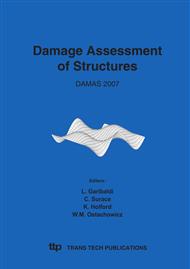p.69
p.77
p.83
p.89
p.95
p.101
p.107
p.115
p.121
Damage Localization Using Levenberg-Marquardt Optimization
Abstract:
In this paper, an optimal solution method is proposed for determining the location of change, i.e. damage, within a perturbed system utilizing a nonlinear pseudo-second order search algorithm based on function evaluations and gradient information. This method is applied to damped vibrating systems and utilizes stiffness matrix sensitivities to determine the direction of search within the estimation. The site of damage (location of change) is the solution which minimizes the error between the predicted and measured change. A by-product of the Levenberg- Marquardt algorithm is an estimation of the magnitude of the change within the system which correlates to damage extent. A second-order model of a dynamic system is used, and an approximation is developed to describe small perturbations within the system.
Info:
Periodical:
Pages:
95-100
Citation:
Online since:
September 2007
Authors:
Keywords:
Price:
Сopyright:
© 2007 Trans Tech Publications Ltd. All Rights Reserved
Share:
Citation:


